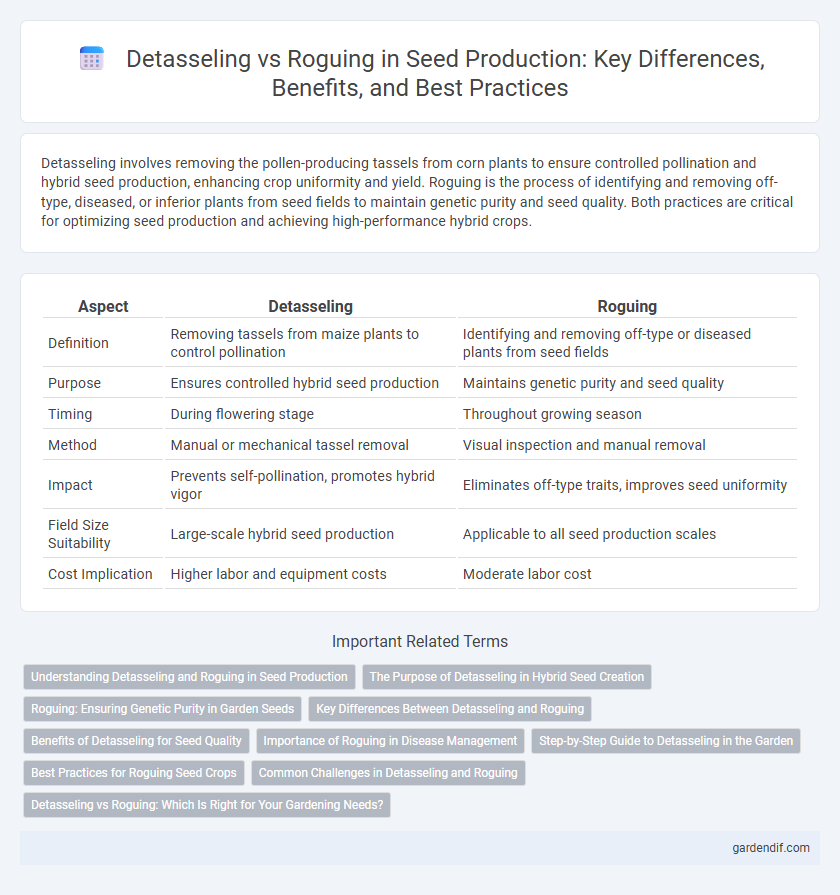
Detasseling vs Roguing Illustration
Detasseling involves removing the pollen-producing tassels from corn plants to ensure controlled pollination and hybrid seed production, enhancing crop uniformity and yield. Roguing is the process of identifying and removing off-type, diseased, or inferior plants from seed fields to maintain genetic purity and seed quality. Both practices are critical for optimizing seed production and achieving high-performance hybrid crops.
Table of Comparison
| Aspect | Detasseling | Roguing |
|---|---|---|
| Definition | Removing tassels from maize plants to control pollination | Identifying and removing off-type or diseased plants from seed fields |
| Purpose | Ensures controlled hybrid seed production | Maintains genetic purity and seed quality |
| Timing | During flowering stage | Throughout growing season |
| Method | Manual or mechanical tassel removal | Visual inspection and manual removal |
| Impact | Prevents self-pollination, promotes hybrid vigor | Eliminates off-type traits, improves seed uniformity |
| Field Size Suitability | Large-scale hybrid seed production | Applicable to all seed production scales |
| Cost Implication | Higher labor and equipment costs | Moderate labor cost |
Understanding Detasseling and Roguing in Seed Production
Detasseling and roguing are essential practices in hybrid seed production to ensure genetic purity and maximize yield. Detasseling involves removing the tassels of the male parent plants to prevent self-pollination and facilitate controlled cross-pollination, primarily in crops like corn. Roguing consists of identifying and removing off-type, diseased, or genetically inferior plants from seed fields to maintain seed quality and uniformity.
The Purpose of Detasseling in Hybrid Seed Creation
Detasseling in hybrid seed creation is essential to control pollination by removing the male flowers on the female parent plants, ensuring that only desired pollen fertilizes the ovules. This process promotes genetic purity and maximizes hybrid vigor by preventing self-pollination and contamination from other corn varieties. Roguing, in contrast, involves removing off-type or diseased plants to maintain overall seed quality but does not directly influence pollination control like detasseling does.
Roguing: Ensuring Genetic Purity in Garden Seeds
Roguing plays a critical role in maintaining genetic purity by systematically removing off-type or unwanted plants from seed crops, preventing cross-contamination and preserving desired traits. This selective process enhances the uniformity and overall quality of garden seeds, ensuring high germination rates and consistent crop performance. Proper roguing supports sustainable seed production by safeguarding against genetic drift and preserving the integrity of seed varieties.
Key Differences Between Detasseling and Roguing
Detasseling involves the removal of corn tassels to control pollination and improve hybrid seed purity, while roguing is the process of identifying and removing off-type or diseased plants to maintain genetic integrity and seed quality. Detasseling is primarily conducted during the flowering stage, whereas roguing occurs throughout the growing season based on phenotype assessment. These distinct practices complement each other by ensuring uniformity and high-performance seed production in commercial agriculture.
Benefits of Detasseling for Seed Quality
Detasseling enhances seed quality by promoting controlled cross-pollination, which increases genetic diversity and hybrid vigor in crops like corn. This targeted pollination leads to higher yields and improved uniformity in seed traits, ensuring better resistance to diseases and environmental stress. Compared to roguing, detasseling directly influences hybrid seed purity and performance, making it essential for producing superior seed stock.
Importance of Roguing in Disease Management
Roguing plays a critical role in disease management by selectively removing diseased or genetically inferior plants to prevent pathogen spread and ensure seed purity. Unlike detasseling, which promotes hybrid seed production, roguing directly targets the elimination of infection sources, reducing the risk of epidemics and improving crop health. Effective roguing enhances yield quality and protects seed stocks from contamination, making it indispensable in sustainable agricultural practices.
Step-by-Step Guide to Detasseling in the Garden
Detasseling in the garden involves carefully removing the tassels of corn plants to control pollination and improve seed quality. Begin by identifying and selecting healthy plants, then use clean gloves to pinch off the tassels before pollen release, ensuring cross-pollination from desired plants only. Monitor plants regularly to maintain effective detasseling, enhancing hybrid seed production and preventing unwanted self-pollination.
Best Practices for Roguing Seed Crops
Roguing seed crops involves systematically identifying and removing off-type, diseased, or genetically inferior plants to maintain seed purity and quality. Best practices for roguing include conducting multiple inspections throughout the growing season, using trained personnel for accurate identification, and promptly removing rogue plants to prevent cross-pollination and contamination. Proper roguing enhances genetic uniformity, improves crop yield, and ensures compliance with seed certification standards.
Common Challenges in Detasseling and Roguing
Detasseling and roguing are essential practices in hybrid seed production, but both face common challenges such as labor intensity, timing precision, and genetic purity maintenance. Detasseling requires skilled labor to remove tassels at the correct growth stage to prevent self-pollination, while roguing demands careful identification and removal of off-type or diseased plants to ensure seed quality. Maintaining compliance with isolation distances and environmental factors also complicates both processes, impacting overall seed yield and hybrid vigor.
Detasseling vs Roguing: Which Is Right for Your Gardening Needs?
Detasseling and roguing are crucial seed management techniques that enhance crop quality and yield, with detasseling involving the removal of corn tassels to control pollination and create hybrid seeds, while roguing focuses on identifying and removing defective or off-type plants to maintain genetic purity. Farmers aiming for hybrid vigor typically choose detasseling, as it directly influences cross-pollination and seed production, whereas roguing serves gardeners prioritizing uniformity and disease control in seed stock. Selecting the right method depends on your specific gardening goals, crop types, and desired outcomes for seed quality and field performance.
Detasseling vs Roguing Infographic

 gardendif.com
gardendif.com